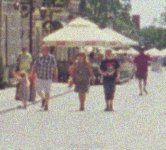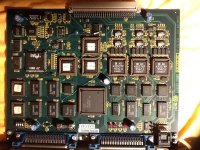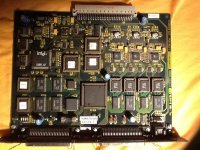You are using an out of date browser. It may not display this or other websites correctly.
You should upgrade or use an alternative browser.
You should upgrade or use an alternative browser.
Post your drum scans (aka the first official Drum Scanners thread)
- Thread starter tsiklonaut
- Start date
- Latest activity Latest activity:
- Replies 729
- Views 193K
jzagaja
Well-known
Since I have Color Trio 1.1 and didn't know there was a newer one 😀 Is 2.0.1 for Mac? Does it work under OSX?
It is for Mac and works very nice. I don't use OSX because I can't get scanner to be seen but I think this is an issue of terminator - have both passive and active and sometimes I must change one to another or SCSI port in the scanner A or B - this means I need more trials with OSX. Please check on your OSX - which version do yo use?
I learnt how to align the drum and it's quite easy - yes movements must be really small.
Now I need to find Tx pin to be able to communicate with the scanner service program.
tsiklonaut
Well-known
Jack, I sent you a mail about the CT.
tsiklonaut
Well-known
jzagaja
Well-known
Fernando2 - how did you exchange drum motor? Which model? Did you perform zero vertical position?
tsiklonaut
Well-known
Islamic Republic of Iran on Ilford XP2
Islamic Republic of Iran on Ilford XP2

Light of Allah by tsiklonaut, on Flickr

Light of Allah by tsiklonaut, on Flickr

Dome Mosaic by tsiklonaut, on Flickr
Islamic Republic of Iran on Ilford XP2

Light of Allah by tsiklonaut, on Flickr

Light of Allah by tsiklonaut, on Flickr

Dome Mosaic by tsiklonaut, on Flickr
Wburgess
Established
Incredible detail... And im not just talking about the scanning.
Overwhelming craftsmanship.
Overwhelming craftsmanship.
jzagaja
Well-known
tsiklonaut
Well-known
Incredible detail... And im not just talking about the scanning.
Overwhelming craftsmanship.
Thanks 🙂
Here is 5000 ppi crop from 35mm Ektar (white cal + focus cal), emulsion facing toward drum with paraffinum liquidum. Aperture 1. Image doesn't look nice. I've used Color Trio 16 bit mode.
The picture looks like it's bad optics (unsharp lens?) or out of focus since the scanning sample dots seem to be pretty sharp (meaning the actual emulsiuon is in focus?). Try using some sharper films you have.
Since I've got the CT version 2 from you it looks like in CT creates the true linear TIF, meaning too dark. For smartly done positive scas the 8bit is enough, but for negatives it's not a good solution IMHO, although I've seen pro PP people do miracles even with 8bit negative scans. But for usable 16bit scans the CQ is probably better choice than the CT.
From this assume the above normal noise is probably a combination from the smallest 3-micron aperture which is already more "fuzzy" (smaller aperture = sharper sampled details over emulsion's thickness but the payoff is less light = more noise) by nature than the bigger apertures and with the levelling out of the linear TIF you only amplify it. I assume it's also a negative film, thus inverted and even more noise introduced(?) With C41 films I'd almost always recommend to use bigger apertures.
Not sure about the paraffinum liquid, I'd recommend KAMI SLX2001 and DC2001 for the drum cleaning to be sure both the film and the drum is protected from harm in the longer run. Their negative cleaning liquid and swipes are also good, but the usual negative cleaners also mosty works for this purpose.
Margus
jzagaja
Well-known
This is interesting because scanner had problem finding focus on Ektar - here found it but as you see probably wrongly. If scanned negative is in log domain then 8 bit is ok.
As far as I know paraffinum oil and naphta is what Kami/SDS are based on. Problem is of course shipping - more exepensive than product. Looking for mylar - maybe foil for handwriting aka "overhead foil" is good enough - for printers has residues.
As far as I know paraffinum oil and naphta is what Kami/SDS are based on. Problem is of course shipping - more exepensive than product. Looking for mylar - maybe foil for handwriting aka "overhead foil" is good enough - for printers has residues.
jzagaja
Well-known
I've sent my Velvia to company that told me their SM11k is in a perfect shape. From sample I can tell serial number is >200 because of a red cast. Shadow detail is similar maybe slightly better because of red channel. I can conclude my unit (Jack) is in good shape if not better. Looks like older boards had better gray balance.
https://docs.google.com/file/d/0ByP8kkW_h00uUENMVU9WeFRtYlE/edit?usp=sharing
https://docs.google.com/file/d/0ByP8kkW_h00uUENMVU9WeFRtYlE/edit?usp=sharing
tsiklonaut
Well-known
I've sent my Velvia to company that told me their SM11k is in a perfect shape. From sample I can tell serial number is >200 because of a red cast. Shadow detail is similar maybe slightly better because of red channel. I can conclude my unit (Jack) is in good shape if not better. Looks like older boards had better gray balance.
https://docs.google.com/file/d/0ByP8kkW_h00uUENMVU9WeFRtYlE/edit?usp=sharing
Interesting comparison. If there's no PP added then one has slightly better shadow and sharper but more noise (tired PMTs or much smaller aperture?), your's definitely has better overall color balance.
Red-cast issue - I'm not sure if it's a board case or maybe just a different PMT-biasing between them? I reckon this is the most probable cause - just different calibrations considering it's still a same scanner with the same hardware. Many ScanMate 11Ks are known for a slight shadow red-cast when working with CQ that's correctible (since it's not clipping) and some say it can be a software bug as well - i.e. PC vs mac versions of CQ and I've also heard it can depend on if the Virtual Memory function is switchen on or off on mac. I haven't confirmed this myself yet with my setup since mine works allright.
If you say they're having different serial numbers out of curiosity I wonder if this also could be a small difference in optical parts, i.e. slightly different fiber optics or dichrotic filters? If that's the case would be interesting to know if or how much ScanView changed their SM11Ks throughout their production?
jzagaja
Well-known
SM11K >200 has different AD converter - can check exact model. Today I've spoke with photographer who bought SM11K from ABC and he has problem with jaggies from beginning. They sold their warehouse with parts and keep three SM11K - I have four - should I open service point? 🙂
tsiklonaut
Well-known

The Dome by tsiklonaut, on Flickr

Si-o-Se bridge, Iran by tsiklonaut, on Flickr

Omani village (Chinese Lucky SHD b&w film) by tsiklonaut, on Flickr
tsiklonaut
Well-known
SM11K >200 has different AD converter - can check exact model. Today I've spoke with photographer who bought SM11K from ABC and he has problem with jaggies from beginning. They sold their warehouse with parts and keep three SM11K - I have four - should I open service point? 🙂
Makes sense then if it's the A/D. Wonder if it was a move from 12bit to 14bit change? Since most of the drum scanners were 12bit at best, very few drumscanners were operating at true 14bit depth like the ScanMate 11Ks in the early 90s.
Also now I know who to turn to for parts 😉
jzagaja
Well-known
jzagaja
Well-known
tsiklonaut
Well-known
Can't find much info on AD43057XP chip. So not sure if it's 8, 12 or 14bit like the later AD converters. The later 14bit AD9243AS chip is well documented.
And indeed those control boards look different.
I'd be interested to know if they're compatible (i.e. can you use <200 board in >200 SM11K)? And how they compare scanning quality wise - i.e. does the older board have its own issues (i.e. jaggies or the stripes in the shadows or noisy highlights issue)?
I have the newer board with 14 bit AD and had to send it to ABC Scan for modification to remove the stripes in the shadow issue that seems to be common quirk on all 11Ks according to ABC scan, would be interesting to know if it affects the older <200 boards as well?
And indeed those control boards look different.
I'd be interested to know if they're compatible (i.e. can you use <200 board in >200 SM11K)? And how they compare scanning quality wise - i.e. does the older board have its own issues (i.e. jaggies or the stripes in the shadows or noisy highlights issue)?
I have the newer board with 14 bit AD and had to send it to ABC Scan for modification to remove the stripes in the shadow issue that seems to be common quirk on all 11Ks according to ABC scan, would be interesting to know if it affects the older <200 boards as well?
tsiklonaut
Well-known

Girl by tsiklonaut, on Flickr

Purple hair by tsiklonaut, on Flickr

Trailing Oz by tsiklonaut, on Flickr
jzagaja
Well-known
I'd be interested to know if they're compatible (i.e. can you use <200 board in >200 SM11K)? And how they compare scanning quality wise - i.e. does the older board have its own issues (i.e. jaggies or the stripes in the shadows or noisy highlights issue)?
They are compatible. I can check everything. How should I do it? 🙂








